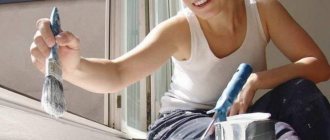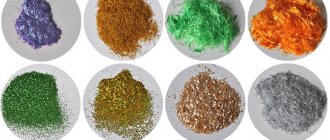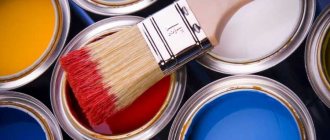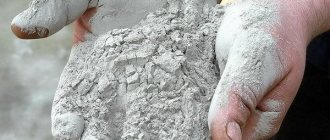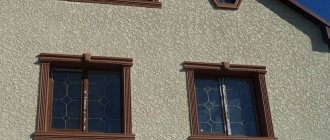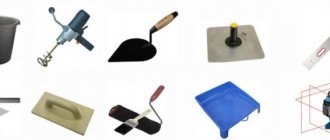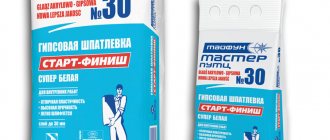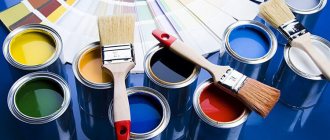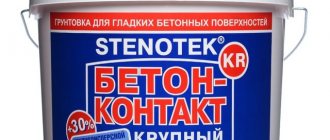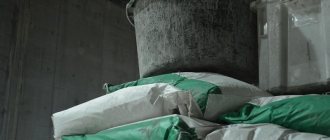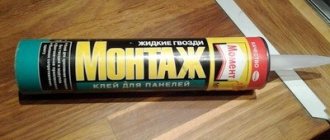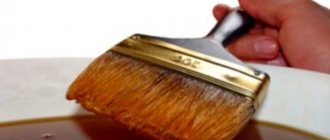One of the effective ways to protect the surface from the influence of external factors, such as moisture or minor mechanical damage, is to create a varnish coating. Water-based acrylic varnish, also known as polyacrylic, copes well with this function. It also adds additional aesthetics to the appearance of any structure. Taking into account the modern trend towards the use of environmentally friendly materials, this type of coating is one of the most popular finishing compositions.
Water-based varnishes: general information
Water-based varnish or aqualac is a popular paint and varnish material that is a worthy alternative to alcohol-based varnishes. This is an environmentally friendly material that has long won the love of ordinary people, especially those who care about their own health and prefer to surround themselves with environmentally safe things.
This decorative and finishing material consists of natural components, which means it is not characterized by toxic fumes or unpleasant odors, it is easy to use and protects wooden surfaces from destruction and damage for a long time.
Characteristics of acrylic varnish
Many people are interested in what perfect qualities this composition has gained enormous popularity in the construction industry. Let's take a closer look at the physical and chemical characteristics of this paint and varnish material:
- The water-soluble composition is initially supplied in a viscous-flowing state.
- The working fluid is almost odorless.
- Drying time – up to 4-6 hours.
- The best acrylic varnish, when the applied composition dries, forms a transparent, shiny and colorless film that is resistant to negative factors.
- It is allowed to mix varnish with water-dispersed paints.
- To reduce the thick consistency, it is diluted with an aqueous solvent.
- Acrylic varnish for furniture must not be diluted with chemicals: drying oil, acetone, gasoline, white spirit.
Composition of scuba tanks
The safety of water-based varnish is also indicated by its composition, because aqualak consists exclusively of water and natural emulsifiers (substances capable of creating an emulsion from immiscible components).
The emulsifier in such a varnish can be one of two substances:
- acrylic;
- polyurethane.
In addition to the main components, the composition may contain excipients:
- antiseptics (protecting wood from fungus and pests);
- liquid polymers;
- plasticizers (thanks to them, the varnish acquires the necessary strength);
- solvents (their share can range from 5 to 15%).
Classification of water-based varnishes
All scuba gear can be divided into two large groups:
- Single-component. They are called so because they contain only one active component - acrylic or polyurethane;
- Two-component. The name suggests that this paint and varnish material contains two polymers at once - acrylic and polyurethane.
One-component varnishes
- Acrylic varnishes
Most experts call these varnishes the most environmentally friendly among all paints and varnishes. Unlike many other varnishes, this material does not create a dense varnish film on the surface, and this circumstance allows the wood to “breathe”. It should be noted that the elasticity of acrylic varnishes is much higher than that of competitors. This feature makes applying varnish a simple task that even a non-professional can successfully handle.
At the same time, acrylic varnishes also have some disadvantages. First, they are not as durable as their polyurethane counterparts. And secondly, these materials are more suitable for covering surfaces inside a building, while when processing external surfaces they do not demonstrate their best qualities.
The disadvantages of acrylic varnish include the loss of its protective properties at temperatures below -25ºC. In such conditions, the varnish begins to crack, which means it will require restoration in the future. Acrylic varnish is also unstable to high humidity. In such an uncomfortable environment, it quickly becomes cloudy, bubbles may appear on it, but even worse, it begins to lag behind the base.
Experts agree that water-based varnishes with an acrylic base perform excellent indoors, but are completely unsuitable for finishing facades and outdoor use.
- Polyurethane varnishes
These are extremely durable paint coatings that are many times superior to their acrylic “brothers” in terms of reliability and ability to withstand external negative influences. It is not without reason that polyurethane varnishes are used to treat the internal and external surfaces of administrative buildings and structures.
These materials are able to withstand high mechanical loads and are resistant to damage. We can say that these varnishes are universal and have a wider range of applications than acrylic-based coatings.
Two-component varnishes
As mentioned above, two-component varnishes contain two active components at once. In this case, acrylic is considered the main one, and polyurethane is added to improve the performance characteristics of the material.
Practice shows that varnishes containing both components are the most reliable and wear-resistant, and therefore are used in intensively used premises. The surface, protected by a two-component material, has additional protection from chemical influences, the ingress of alcohol and other liquids, and also perfectly withstands increased operating loads (including impacts). Moreover, two-component varnishes are fire resistant, which means they can protect your home from fire! In addition, they do not have an unpleasant odor, which is also a plus when choosing a suitable material for protecting wood.
Features and main qualities
This paint and varnish material is sold in a form ready for application. This allows you to immediately begin surface treatment after purchase. However, if necessary, it can be diluted with water, but the amount of this solvent should not exceed 10% of the total amount. Thus, in most cases the problem of how to dilute acrylic varnish does not arise.
It should be borne in mind that there are acrylic varnishes that are suitable for coating interior surfaces, and there are options intended for exterior use. Thanks to its special molecular structure, this material is characterized by high penetrating ability and versatility, i.e. it can be applied to most types of surfaces, including:
- cardboard;
- wallpaper;
- tree;
- brick;
- glass;
- plastic;
- decorative plaster, etc.
In addition, this material is indispensable when the question arises of what varnish to coat acrylic paint with. Wood surfaces often have to be coated with acrylic varnish in several layers. This is because the water contained in this material can be absorbed into the wood fibers, causing them to swell. Because of this, after the first treatment the surface may become slightly rough and unattractive.
To eliminate this effect, additional sanding is often required after the first layer has been applied and dried. After this, a second layer is applied. At the same time, impregnation of wood and other coatings with varnish increases their protection from the effects of various factors.
Types of varnishes by texture
When choosing a varnish, maintaining the texture of the wood treated with a protective layer is of great importance. In this regard, scuba tanks can be divided into 3 types:
— Glossy varnish. This is a classic version of varnish coating that creates an absolutely transparent shiny film on the surface. In addition to its pronounced shine, the varnish layer is extremely durable and abrasion-resistant. By the way, in addition to transparent glossy varnish, you can find on sale material with shades, for example, gold or silver.
- Matt lacquer. To achieve a noble matte surface, manufacturers mix urethane and alkyd resins. As a result, after application, an opaque thin film is formed on the surface, no less reliable than a glossy varnish, but more seasoned and noble.
— Semi-matte varnish. Semi-matte material is extremely popular among acrylic varnishes. Perfectly highlighting the structure of the wood, this varnish creates a chic, unobtrusive shine.
Important! It should be noted that semi-matte varnish can only be applied to perfectly polished surfaces, because even the smallest imperfections under a layer of semi-matte varnish will be clearly visible.
Why does the surface need to be varnished?
Most building materials, incl. brick, wood, concrete, etc., differ in their ability to absorb various pollutants. Because of this, the surface quickly loses its attractive appearance. To prevent this, it is imperative to varnish these materials.
In addition, the varnish coating protects materials from exposure to various environmental factors, which increases their service life. Coating floors with this composition prevents the appearance of defects and rapid rubbing. The use of such a coating helps improve the decorative qualities of surfaces.
Advantages of water-based varnishes
Aqualacs successfully compete with alcohol-based paints and varnishes due to a number of advantages. In this regard, the main advantages of this material include:
- Environmentally friendly. The natural base of Aqualak is a key advantage that other paints and varnishes cannot boast of. During the process of application and drying, this material does not form toxic fumes, which means you and your household will be completely safe, both during all finishing work and during operation.
- Economical. Based on the ratio of price and consumption per 1 sq.m. surface, this material outperforms many competitors, which attracts increased attention from buyers.
- Fast drying. Water-based varnishes dry quite quickly (no more than 5 hours until completely dry). Moreover, some types of varnish dry in literally 2-3 hours. This feature allows you to significantly save time during repairs, and this is another important advantage.
- Fire resistance. Most paint and varnish coatings are fire hazardous because they consist of alcohols and resins. But this material, which is 85% water, is not subject to combustion and behaves well even near stoves and portable heating devices. Moreover, this varnish can be used as a protective material in areas with a high fire hazard.
- Durability. Practice shows that scuba tanks are 1.5 times more durable than alcohol-based paints and varnishes. And this fact, taking into account the affordable price of such material, makes water-based varnishes extremely attractive in the eyes of the buyer.
- Reliable protection. Any varnish covers the wooden surface with a protective film. However, even a scuba film provides the most reliable protection. The fact is that the surface tension of this film is not too strong, and therefore it is less prone to cracking and better withstands mechanical pressure and shock.
- High adhesion. Thanks to the high level of adhesion, this material reliably adheres to the working surface and stays on it for many years without coming off, cracking, or chipping.
- Antiseptic properties. Water-based acrylic varnish has the ability to resist fungus, bacteria and pests that can damage wood. In this regard, acrylic varnish can be used to treat surfaces located in rooms with high humidity (kitchen, bathroom). But it is better to avoid treating façade parts with acrylic varnish.
- UV resistance. Water-based varnishes withstand exposure to sunlight very well. Even after prolonged exposure to the sun, they do not fade, become cloudy or crack.
What it is?
Acrylic varnish is crushed plastic dissolved in acrylic. After drying, this composition forms a thin, colorless acrylic film with high resistance to mechanical damage.
The main substances that make up the varnish fit into three points:
- liquid polymer (acrylic);
- antiseptic (to protect wood from moisture and pests);
- plasticizer (the main component that gives the coating maximum strength and durability).
Acrylic varnish is a ready-to-use substance: homogeneous, transparent, practically odorless. It is based on high-quality acrylic resins, not burdened with color, and water dispersions.
To get acquainted with this almost universal coating, you should highlight its main properties and characteristics.
- Acrylic varnish is a liquid. It is characterized by high viscosity and the ability to dissolve in water.
- One of the pleasant features is the minimal presence of odor (at least unpleasant).
- Despite the fact that this type of varnish is water-soluble, it cannot be washed off after drying.
- The film that appears in place of the dried acrylic varnish has increased elasticity and wear resistance.
- The coating does not lose its transparency even over time and under the influence of sunlight.
- If necessary, this varnish is even recommended to be mixed with water-soluble paints.
- Ideal for exterior and interior use. It interacts well not only with wood, but also with brick.
Disadvantages of water-based varnishes
- The need to comply with technological conditions. It should be noted that aqualak is a capricious material, the operation of which requires compliance with a number of conditions. In particular, in the room where this material is used it is necessary to maintain the temperature within the range from -15ºC to + 20ºC. And the humidity level should not go beyond the range of 55-60%. If these conditions are not met, the durability of the water-based varnish will be noticeably reduced, it will quickly begin to become cloudy, and the wood underneath will darken.
- The need to humidify the air during the application of varnish. To obtain the most durable surface film, water-soluble varnish should be applied at an air humidity of around 50%. To achieve this indicator, the air in the room will have to be regularly humidified using a sprayer.
- The need to apply several layers. To ensure high-quality protection of the wooden surface, water-based varnish should be applied in several layers.
Assessing the pros and cons of this material, many ordinary people agree that the advantages of aqualak many times exceed the disadvantages of this material. Thus, if you have to varnish a small area, and especially inside the house, water-based varnish should be the material of choice.
Application technology
As mentioned above, any work with acrylic varnish for wood should begin with surface preparation. If the wood being treated is covered with an old layer of varnish, it should be removed using chemicals, hand tools or thermal methods. After removing the old varnish, the product is cleaned of dust, degreased with a soap solution and coated with a primer.
Acrylic varnishes for wood should be applied to a dry surface in several layers - in special cases their number can reach up to 5-6. After applying each layer, you must wait until it dries and sand it with fine sandpaper. It is recommended to sand the penultimate layer on a damp surface, that is, moisten the coating, sand it with sandpaper and only then apply the finishing layer.
To create the perfect surface, it doesn’t hurt to use a few useful tips:
- When processing products, drafts and exposure to direct sunlight should be avoided;
- according to the instructions, each subsequent layer can be applied 30–120 minutes after the previous one, but, as practice shows, it is best to leave the varnish to dry for at least 4 hours;
- If you want to give the product a noble shade, you can initially apply tinting impregnation to it, and then colorless acrylic varnish for wood (alternatively, the varnish is diluted with impregnation in a 5% ratio).
Scope of application of water-soluble varnishes
Depending on the varieties, and therefore the presence of certain properties, the scope of use of scuba tanks may differ significantly.
— Water-based acrylic varnishes are not the most suitable choice for flooring, and this is why this material does not tolerate increased loads. If you choose them as a floor covering, then only for non-traversable rooms in which many people do not gather.
— For a small room in which minimal load will be placed on the floor, it is enough to purchase a one-component varnish. In addition, it is sold ready-made and does not require additional components.
— If you have to apply a coating to a large living room floor, pay attention to a two-component varnish. Remember that before use, the main component must be combined with a hardener, thoroughly mix the resulting mixture, and only then begin work. In addition, depending on the level of humidity in the room, various antibacterial components and surface-strengthening plasticizers can be added to the varnish.
Important! If you need to cover wooden parquet made of larch or pine, you should opt for a two-component varnish.
— One-component acrylic varnishes are not intended for covering outdoor surfaces. If you decide to ignore this rule, be prepared for the fact that under the influence of scorching sun and wind, fog and snow, this coating will last no more than 1 year.
— Bearing in mind the environmental friendliness of water-soluble varnish, that during application and during operation it does not emit formaldehyde and other dangerous toxins, you can safely treat floors, ceilings and walls in a bedroom or children’s room with this varnish.
— In addition, acrylic varnish is often chosen by masters of decorative and applied arts for their works. This material is often used to cover decorative elements in the interior.
— Polyurethane varnish is stronger and more wear-resistant, and therefore it is used for treating floors or walls in administrative buildings, trade pavilions and educational institutions.
— Finally, when choosing a varnish for the floor, walls or window frames, remember that such a coating should highlight the advantages of the main surface. In this regard, in a poorly lit room where sunlight rarely reaches, glossy varnish looks better. But in a bright and sunny room, matte and semi-matte varnish looks exceptionally noble.
How do you know when a painting is ready to be varnished?
Of course, it all depends on the type of paint in your painting.
If we are talking about a painting painted with acrylic or gouache, for example, you painted a picture by numbers or worked in the fluid art technique, then such works dry completely within a week, and can be varnished after two days.
Dry materials (charcoal, sepia, etc.) are covered immediately.
Thought paints take the longest to dry, from 6 to 12 months, and the drying time depends on a whole series of factors: how much paint was applied, whether the layers dried gradually or whether you painted the picture all at once, etc.
It is very easy to check whether the painting is dry - run a white cloth over the area of work with a light movement. If there are not even subtle traces of paint on it, then you can start varnishing.
Where to use water-based varnish
We list the surfaces and products that are most often treated with water-based varnishes.
- wooden surfaces of the facade of a house or bathhouse, gazebos and other buildings (except acrylic varnish);
- walls, ceilings indoors;
- parquet, laminate or deck board floors;
- wooden stairs and window frames;
- brick, panel, glass, metal and plastic surfaces, plaster and even wallpaper;
- wooden toys and wooden children's accessories.
Why does acrylic varnish stick after drying?
If the deadlines specified in the instructions have passed, and the finishing layer remains soft, it means that at some stage the technology was broken. Extremely long drying of the surface brings a lot of inconvenience and prevents items from being used for their intended purpose. The reasons why acrylic-based varnish remains sticky are the following:
- The paint material is old.
- Furniture acrylic varnish is initially of poor quality; the amount of driers (auxiliary elements to speed up drying) in the material is insufficient.
- The solution was criminally diluted in the warehouse by sellers to increase the volume.
- High content of tannic acid in the wood surface.
- Acrylic-based varnish contains an unspecified plasticizer that leaves the surface soft.
- Working in a damp and cold room.
- Application of excessively thick layers of varnish.
- The finishing layer was applied before the previous one was completely dry.
- Using contaminated tools.
How to apply water-soluble varnish
Working with aqualak is not the most technically complex process, but it has a number of features that you need to know before applying this paint coating. So:
1. Before you start applying varnish to a wooden surface, it must be prepared. Using fine sandpaper, it is important to remove the previous coating, be it paint or varnish. If you have to work with freshly laid parquet or laminate, you can simply remove surface dirt and wipe the floor with a damp cloth.
If there are defects on the wooden surface (cracks, gouges, dents), they must be puttied and also treated with sandpaper. After waiting for the surface to dry completely, you can move on to the next stage.
2. Before applying varnish, the surface must be treated with a primer. Ideally, the primer mixture should have a base similar to varnish (a wood primer is suitable for aqualac applied to wood). Naturally, both protective materials must be water-based.
3. The primer mixture needs to dry thoroughly, for which you need to wait a day. After the allotted time, you need to walk over the dried surface with fine sandpaper and remove dust with a vacuum cleaner.
Important! Ideally, 2-3 layers of primer should be applied to the wall. This will not only strengthen the wall, but will also reduce varnish consumption.
4. Prepare the necessary tools to coat the surface with varnish. You will need the aqualak itself, a roller and a container in which it is convenient to wet the working tool.
Important! Water-soluble varnishes cannot be applied with brushes. To work with such material, you should use a roller, and if the surfaces are too large, a spray gun. The brush leaves large stains that will be visible to the naked eye. Therefore, even in hard-to-reach places it is better to use rollers of appropriate size.
5. Fill the tray with varnish, and if necessary, mix the ingredients and mix them thoroughly. After moistening the roller in the finished varnish, begin to roll it over the wall.
Important! Please note that the varnish is applied along the wall and leveled across. The movements should be soft and smooth, and the wall should be varnished without gaps.
6. After allowing the first layer to dry, which is approximately 3-4 hours, you can apply the second. According to experts, a reliable varnish coating requires the application of 3-5 layers.
7. After applying the surface coating, leave it for a week until completely dry. And after that, you can arrange furniture in the room without fear of scratching the varnished floor.
How to remove acrylic varnish?
High-quality water-dispersed material forms a strong layer after drying. Old stains are a serious problem, so it is better to wipe up any accidentally spilled polish immediately. If you cannot clean the surface with heat treatment or an abrasive tool, you can use the following chemicals:
- Waterproof acrylic varnish can be removed from clothing using gasoline or solvent. The exception is brightly colored fabric; after processing, unwanted stains may appear on it.
- For furniture and other wood coatings, it is better to use a professional remover - Zip-strip 1Q, APP, Kompozit, Neomid SU-30 and others. The product is applied for 3-4 hours, and then the split varnish is removed with a spatula. Finally, the remaining chemical solvents are washed off with water.
Popular manufacturers
The market for paint and varnish coatings is replete with the names of companies, each of which is ready to offer its own unique product. We chose the most popular manufacturers, according to buyers.
- Tikkurila
These are branded products that have long earned the love of customers due to their consistent quality and durability. Tikkurila is especially famous for its acrylic water-soluble varnishes. They are ideal for interior decoration, especially rooms that rarely receive sunlight. With prolonged exposure to ultraviolet radiation, this coating begins to deteriorate. And its consumption per 12 sq.m. is 1 liter.
- Eurotex
Among domestic manufacturers of paint and varnish products, this company is a leader, and all thanks to its versatility, ability to retain moisture, resistance to chemical attack and affordable price. In addition, 1 liter of varnish can cover 17 sq.m. surfaces. One has only to take into account that such a coating is not applied to old layers.
- 3V3
The French company is famous for its finishing coatings, but the two-component varnishes of this company received special love from customers, because such products have the highest strength and allow you to easily rearrange furniture or hold parties in the house without fear of damaging the varnished floor. The varnishes of this company are odorless, and their service life exceeds 7 years!
- Aqua Parade
This varnish is produced in our country, but from imported components. It boasts a wide range of materials and their excellent properties. Suffice it to say that the scuba tanks of this company are easy to wash, do not allow water to pass through and do not deteriorate under its influence. In addition, Aqua Parade paints are leaders in drying speed. It takes no more than 30 minutes for the layer to dry completely! The disadvantages of this product include only the consumption of 1 liter per 10 sq.m., and the high price for a domestic product.
Varnishing wooden surfaces is a common practice. And to ensure that your efforts are pleasing to the eye even after 5 years, use our advice and choose for yourself only the best water-soluble varnish!
Characteristics of acrylic varnish
Many people are interested in what perfect qualities this composition has gained enormous popularity in the construction industry. Let's take a closer look at the physical and chemical characteristics of this paint and varnish material:
- The water-soluble composition is initially supplied in a viscous-flowing state.
- The working fluid is almost odorless.
- Drying time – up to 4-6 hours.
- The best acrylic varnish, when the applied composition dries, forms a transparent, shiny and colorless film that is resistant to negative factors.
- It is allowed to mix varnish with water-dispersed paints.
- To reduce the thick consistency, it is diluted with an aqueous solvent.
- Acrylic varnish for furniture must not be diluted with chemicals: drying oil, acetone, gasoline, white spirit.
